Annie and Jeff Main started farming after college, inspired by the back-to-land movement of the 1970s. They farmed on rented land for 17 years and then bought their own 20 acres in Capay Valley, in Yolo County. At first, there was nothing around. No house, no barn, no trees — only bare land. They grew food organically and used cover crops to restore soil health, and planted native hedgerows to prevent weeds and provide habitat for beneficial insects.
Over the following decades, the couple built a farm business called Good Humus Produce. They grow certified-organic fruits and vegetables and sell their harvest, along with homemade jams and jellies, directly to consumers at farmers markets and local food co-ops, and through community-supported agriculture boxes. But today the future of their beloved business remains uncertain.
On their farm, they also raised three children who are now adults and off living their own dreams: There’s Zach, a fire engine operator; Alison, a graphic designer; and Claire, a photographer. “We don’t know if they’re not going to take over the farm,” Annie Main says. “We just know it takes everything you got and it takes passion. We didn’t expect our children to do that.”
Claire and Annie Main walk through a peach orchard at Good Hummus
Produce in Capay Valley.
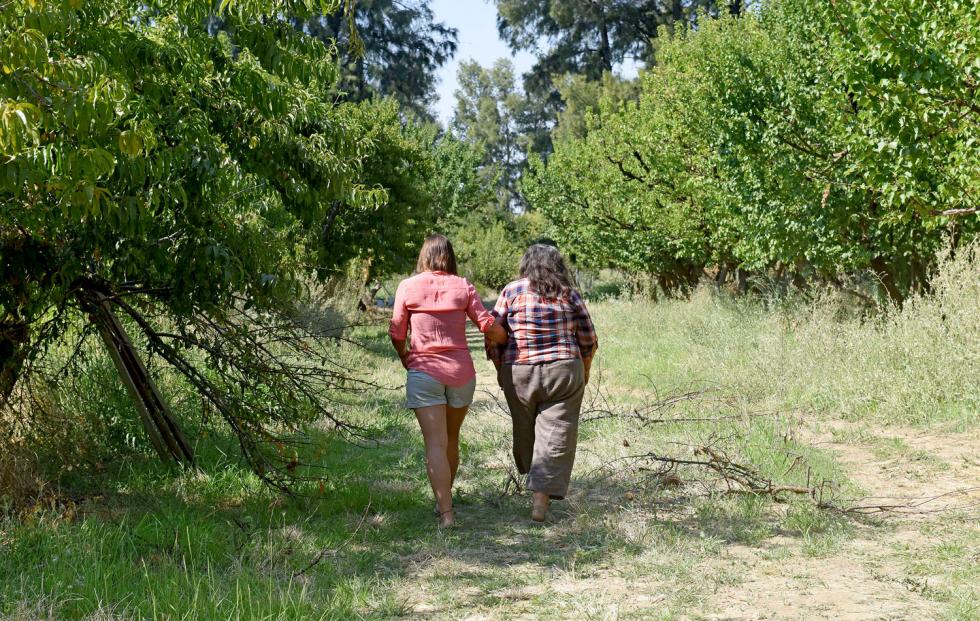
We realized it takes more than one generation to build a farm. I can continue farming knowing this is a base for another generation.” — Annie Main, Good Humus Produce
In 1999, Jeff visited England, where he saw farms passed down among relatives for hundreds of years. “The trip to England clarified the notion that a farm was an ongoing workplace and resource for the community that could evolve and mature within a community for many generations,” he says. The Mains’ children were young then and their career paths still unwritten, but Jeff and Annie didn’t want to dictate their futures. Nor did Jeff and Annie want their work demolished if developers bought the land. “We realized it takes more than one generation to build a farm,” Annie says. “I can continue farming knowing this is a base for another generation.”
So the Mains, both in their 60s now, face a dilemma: How do they transition their farm business to a younger generation of farmers? Should they lease the business, put the land into conservation or sell it all? This succession question is one faced by many farmers and ranchers, as more often than not, their grown children aren’t returning home to run the family business. Meanwhile, a generation of farmers are aging — now averaging 60 years old in California, according to the most recent U.S. Census of Agriculture, which skews slightly higher than the national average of 58.
On the other side are the young, aspiring farmers in dire need of farmland. For generations, new farmers typically inherited land from their parents or relatives. With more and more beginner farmers coming from non-agricultural, college-educated and urban backgrounds, they are faced with buying or renting land from other sources. But the cost of land has skyrocketed: In California, cropland was valued at $10,690 per acre in 2015, which was a 5.4 percent jump over the previous year and makes the state’s land among the most-expensive in the country. Too many young farmers simply can’t afford it.
From left: Jeff, Claire, Annie and Alison Main in their peach
orchard at Good Humus Produce in Capay Valley.
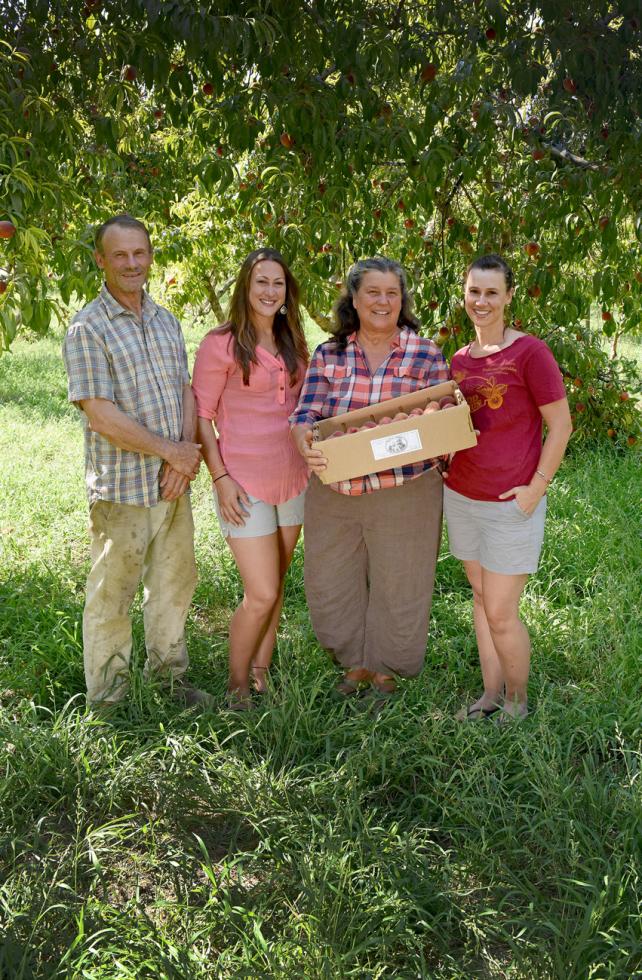
Securing the Easement
The Mains have an idea on how to preserve their legacy and play a minor role in preserving small-scale agriculture by giving a beginner farmer easier access to their land. It’s an idea they’ve been stewing on for years: an innovative agricultural conservation easement.
Generally speaking, an agricultural conservation easement is a voluntary agreement where a landowner places a deed restriction on their farm or ranch to require that it remain in agriculture forever, according to Yolo Land Trust Executive Director Michele Clark. The easement may allow for a small development so the owner may build a house and agricultural-related structures. The owner pays taxes and conducts agricultural practices as desired. Local governments or land trusts hold these easements and ensure the terms are upheld by monitoring the farm or ranch at least once a year. The easement is recorded in the public records and remains in effect when the land changes ownership.
These agreements are usually conservative and straightforward. The Mains’ plan is much more complicated. In addition to permanently removing development rights from the property and stipulating that the land be farmed in perpetuity, the easement states that the land must be farmed according to the requirements of a nationally recognized certifying agency (like for an organic certifier); the farmer/owner must live onsite; and at least 50 percent of the farmer’s gross income must come from farming.
When you have something so great, you want to hold onto it as long as you can.” — Hallie Ochoa, Full Belly Farm
This easement also establishes a resale restriction to make it affordable for beginning farmers. Under the easement, the Mains will still own their land. But if one day they decide to sell it, the land must be sold at the appraised agricultural value (now around $10,700 an acre, but always changing) — rather than the higher market value — to make it affordable for beginning farmers. A licensed appraiser will determine the farm’s agricultural value, say $11,000 an acre, and that will be the full sale price of the farm. The cost of the easement will be determined by the difference between the agricultural and market values, the latter of which will be higher.
Annie and Jeff Main, of Good Humus Produce, examine paperwork for
securing a conservation easement for their farmland
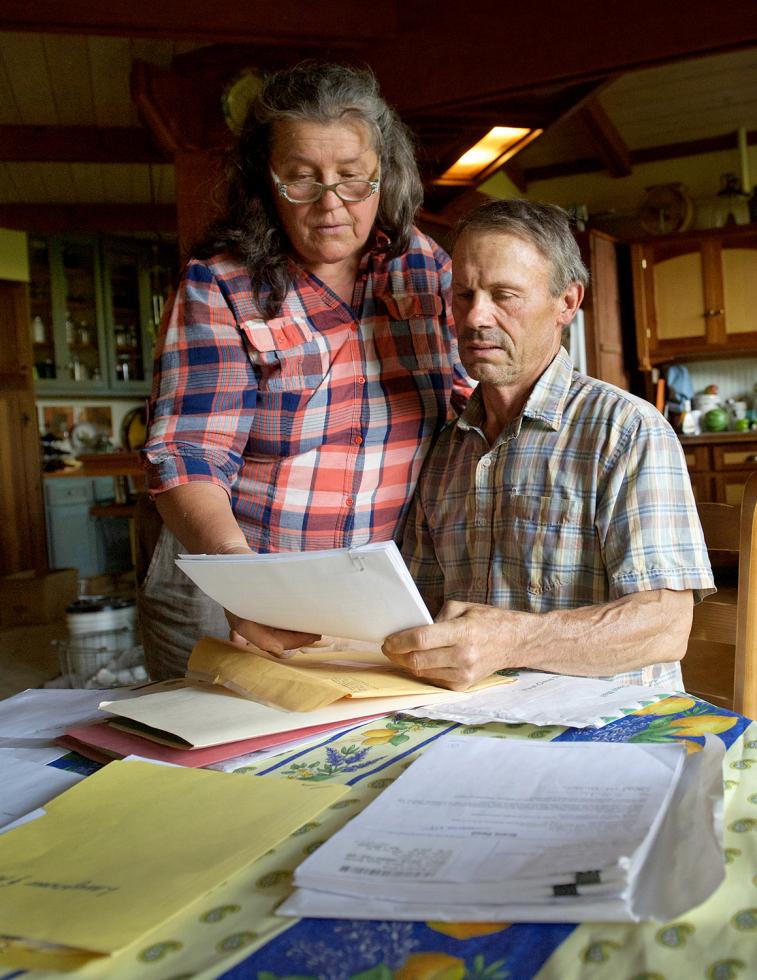
All easements cost money — and are either paid for by land trusts, through fundraising or donated by landowners who can afford to do so. To cover the cost of their easement, the Mains have been raising money with the help of the Sacramento Natural Foods Co-op, Davis Food Co-op, California Farm Link and Twin Pines Cooperative Fund, who together with the Mains make up the One Farm at a Time fundraising organization. Once the agreement is placed with a public land trust, the Mains will receive payment for the easement. They can’t simply donate their easement because, after 40 years of farming, they are saddled with the debt of building a farm from scratch, Jeff Main says. For a farmer, selling his land often serves as his 401k.
The couple first worked with the Yolo Land Trust on the easement. Founded in 1988, the organization has permanently conserved about 11,000 acres of farmland through 60 conservation easements. So they know what they’re doing. But after several years of negotiations, the two parties couldn’t find common ground on all the stipulations the Mains wanted and have since parted ways, Clark says. It was just too risky to move forward.
Related: Strictly Professional
Mary Kimball, executive director of the Center for Land-Based Learning in Winters, served on the Yolo Land Trust’s board when the easement was under review. Being “before its time” makes the easement hard for traditional land trusts to digest, Kimball says. “There are seemingly more risks involved as it is an unproven model,” she says, adding that the Mains, “are thinking ahead, and ensuring that the next generation of farmers can afford critical farmland.”
The Mains have been working with a land trust in Massachusetts for over a year now, but the two parties can’t seem to get the darn thing finalized, once and for all.
Moving Back to the Farm
Also in Capay Valley at Full Belly Farm, not far from Good Humus, the founders lucked out — the next generation chose to follow in their parents’ dusty boot prints. Husband and wife Paul Muller and Dru Rivers co-own the farm, and their son Amon Muller and his wife, Jenna, recently became co-owners as well (there are also two other co-owners for six total). The younger duo also runs a catering business using the farm’s produce, and Amon’s siblings are taking up the family business, as well.
Sister Hannah Muller says she never planned to work on the farm as an adult. “I think I took it for granted when I was growing up,” she says. “I didn’t realize how fortunate I was.” She went to a tiny high school in Esparto where she was active in Future Farmers of America, one of the only extracurricular options offered. Hannah studied sociology and anthropology in college, and joined a student group of urban gardeners where her interest in farming as a career sparked. She saw her siblings return to Full Belly, but didn’t know where she would fit in.
While backpacking in Australia and New Zealand, Hannah began to miss the flowers of Full Belly — she had prepared flower arrangements and bouquets with her mom for weddings and other events. She decided to go back home and resume this job. Her brother Rye Muller also returned and has improved the animal care system and increased the number of laying hens.
From left: Rye Muller, Becca Muller, Paul Muller, Dru Rivers,
Hannah Muller, Hallie Ochoa, Amon Muller, Jenna Muller and dog
Zeus, of Full Belly Farms
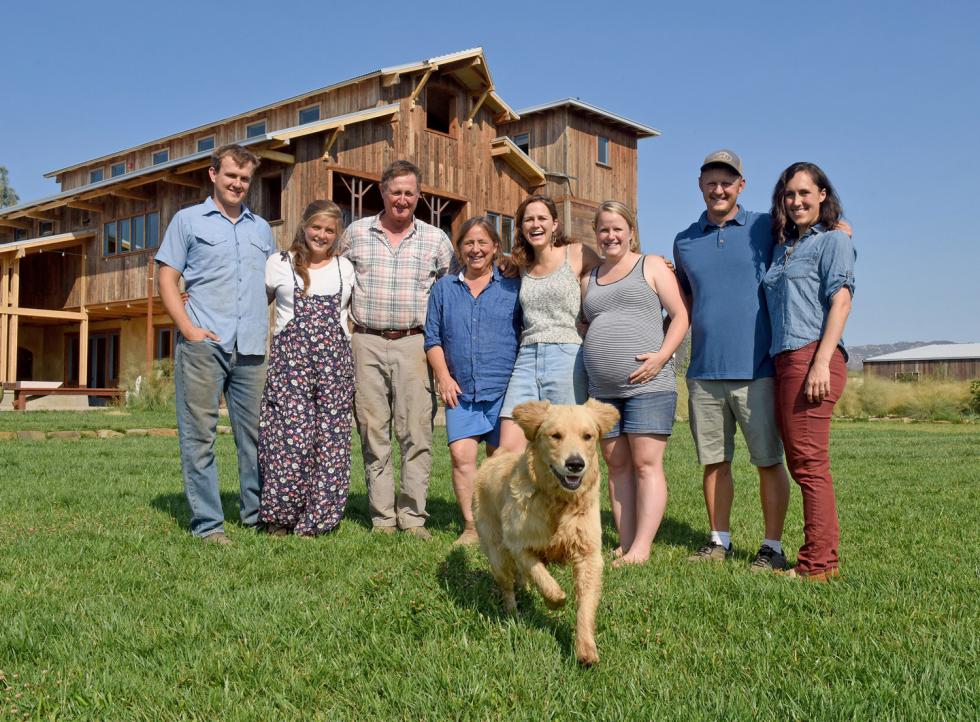
Their sister Hallie Ochoa is the farm’s director of outreach and education. She says the siblings’ new enterprises have allowed their farm business to develop vertically, and not be reliant on expanding acreage in order to grow. Their ventures have created new cash flow for their farm, which is important during seasons with low-value crops. But, she says, they realize that ultimately the production of fruits and vegetables is the priority.
Growing up, Ochoa participated in 4H and Future Farmers of America, and raised animals for the California State Fair. After college, she did a semester at sea, observing farming practices in 14 countries. She returned to Full Belly about seven years ago and, now married and with two children, has no intention of leaving. “When you have something so great, you want to hold onto it as long as you can.”
Trying to Retire
With so many farmers, (the farm) is like their kid. They don’t want to let it go.” — Clark Watanabe, Watanabe Farms
When this year’s tomato harvest is done, Clark Watanabe of Watanabe Farms in West Sacramento plans to retire. He wants to do yoga, put in a gazebo and outdoor dance floor, make his land an urban garden for the community and grow only what he plans to eat. “I want to retire-retire,” Watanabe says. “With so many farmers, it’s like their kid. They don’t want to let it go.” But this plan, he acknowledges, is short-term and doesn’t address what will eventually happen to his land and whether it will be farmed well into the future. “I wish I had a plan. I’ve been thinking about that for 15 years.” He and his wife, Heidi, don’t have any children to inherit the land.
Clark Watanabe and his niece Laurel pick tomatoes at Watanabe
Farms in West Sacramento.
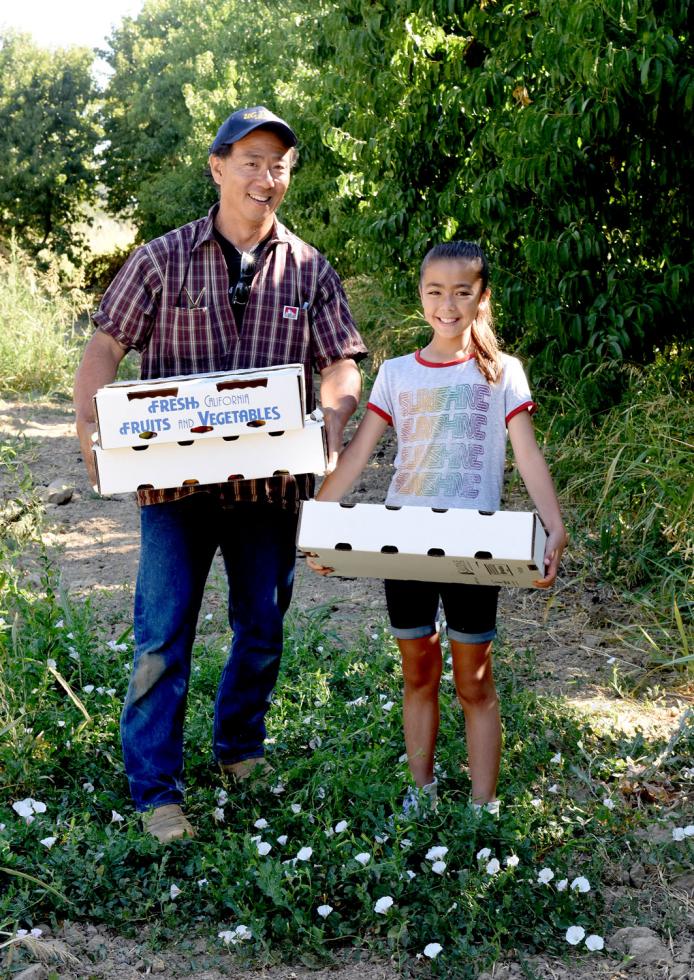
These 7.5 acres have been in Watanabe’s family for 70 years. In the late 1970s, his grandfather bought another 40 acres near Clarksburg to grow mostly radishes, and the smaller parcel was left fallow. About 20 years ago, Watanabe and Heidi started farming the land in West Sacramento. They grow organic heirloom tomatoes, peaches, peppers, squashes, garlic, onion, figs; a little bit of everything. They used to grow winter crops, but scaled back to only one planting this year.
Watanabe Farms has become an institution in the region’s farm-to-fork movement, and a name that many local diners recognize. On Sept. 25, the farm participated in the Tower Bridge dinner gala, the pinnacle of the annual Farm-to-Fork Festival, organized by the Sacramento Convention and Visitors Bureau. Heirloom tomatoes constitute the bulk of the Watanabes’ business; they grow 35 varieties, which they mainly sell to restaurants, including The Kitchen Restaurant and The Waterboy, both in Sacramento. “It’s been a really good year so far,” Watanabe says, plucking a nectarine from its branch on a summer morning.
Through the years, the Watanabes often thought about quitting agriculture. “It’s so much work,” he says, adding that almost all the labor is split between the couple. They considered leasing their land, but couldn’t find the right tenant. “I fought [retirement] for a while, but I’m OK with it.”
The Watanabes are able to retire without selling their land because they set aside money for retirement, which may not be the case for many other farmers who get so engrossed in building their operations that they buy bigger and bigger equipment until they are equipment rich but cash poor. The Watanabes say they have paid for everything in cash.
Watanabe says he doesn’t really know how other farmers are planning for retirement because that topic doesn’t come up often in conversation. But one thing he does want to talk about within his family is who among his nieces and nephews — if any — might want to take over the family business someday. He has found the most interest among his 11-year-old niece Laurel Matthews, who sometimes helps him around the farm, like on an August morning before the school year begins for this sixth grader.
“I thought you said these are the small ones,” Laurel asks her uncle, holding up what appears to be quite a large heirloom tomato.
“That is a small one,” Watanabe declares.
“That’s small?” Laurel asks in disbelief, as she adds the tomato to her pile.
Later, she remarks on her time at the farm: “I like the peaches. I like eating the fruit. I like helping my uncle pick.” And if her dream of becoming a professional soccer player doesn’t pan out, perhaps she’ll consider the farming profession. That’s what Watanabe hopes for: a family member who wants to work the land and continue his business. “If someone is interested in it, then they’re going to get it,” he says. “It shouldn’t be about the money, it should be about who wants to carry it on.”



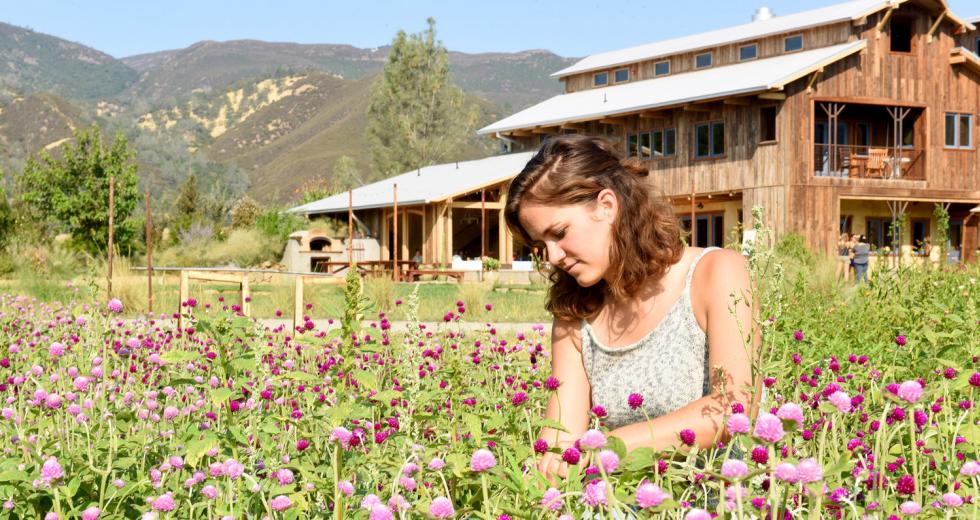

Comments
Great article
my photos from Sena's story